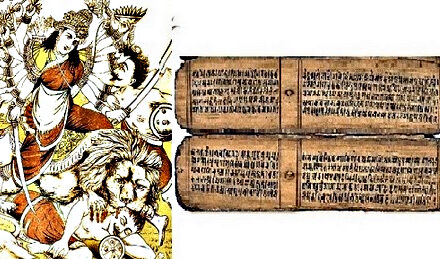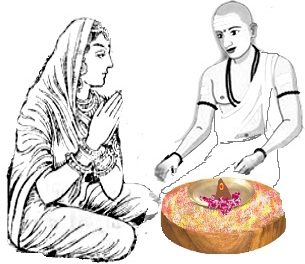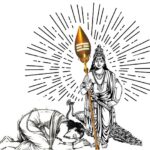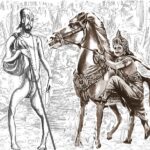
KULA DEVATHA OR TUTELARY/FAMILY DEITIES:
ORIGIN AND CONCEPT
-Santhipriya-
-9-
161) Like present day computer, Lord Brahma would have possessed something similar to present day super computer to meticulously work out details of space where specific sets of divines of various nature, angels or other souls were to manifest. Guiding and guarding specific no of souls (folks) in each space were entrusted to each of the Kula Devatha or Tutelary/Family deity and other divines to be assisted by sub divines of various nature whose space of manifestation were also earmarked. The divines so prefixed for protecting each of the souls in a particular space if failed to adhere to the norms and violated by intruding into the domain of other divines, they would lose their divine power.
162)The Kula Devatha or Tutelary/Family and other divines will go and manifest only in the earmarked spot (spot does not mean a one square feet or square yard in size, but spread over few square meter area). Lord Brahma established this norm so that the deities and divines earmarked to a particular space need not get confused over the spots where they would manifest. After manifesting in the area allotted, the deities ground their divine powers in those spots and get themselves enshrined on the same spot either in a shine or in open spaces in any form as they desire. No norms are stipulated for it and those divines were permitted to choose an appearance and form of their liking and convey the same to the humans either through their dreams or through those in trance to ensure that their statues or idols of worship are accordingly carved out by the people for enshrining in the spot where they manifested.
163) One clear norm of Lord Brahman was that wherever they manifest, that spot would get fully sanctified, grounded with divine energies of those who manifested there so that those who reach and pray in the spot could get invisible divine energy protective cover that guarded and guided them in many ways in their life. Wherever the deities wanted to settle down as ordered, first they went and hid themselves in some place and informed about their places of hiding in the dream of the locals. After the locals reached the places and dug out the idols, they enshrined it in the same place which later became the shrine where the folks visited and offered prayers and obedience. Thus, they became the local temple for the locals who settled there and in due course of time became the Kula Devatha or Tutelary/Family for those folks who settled in that village. Thus in each and every village in some manner or the other, the deities who were destined to settle there, got them identified by the locals in some manner or the other and in course of time became Kula Devatha or tutelary/family deities to the locals there.
164) Can a divine who originally manifested in the space earmarked for them, again manifest in another space? This doubt arises because the same deity in the same form and name is found in many other temples spread in different spaces and the pundits in those temples say that one could offer prayers to the same deity in any of the temples where they have been enshrined. Their contention is incorrect and not acceptable as per Brahman norm. At the same time, the Brahman norm does not prohibit offering prayers to the same deity in any of the temples spread in different other spaces other than the original place where they had manifested first. Therefore those who offer prayers to their Kula Devatha or Tutelary/Family in other temples would certainly receive the blessings in the normal manners bestowed to everyone, but the extent of blessing received would be far different than offering the prayers in the main temple. Many temples exists for Goddess Kathayee (incarnate of Goddess Valli) in different villages spread across Tamilnadu. Similarly another Goddess Tanjamma temple is established in different states like Tamilnadu and Andhra.
165)Let us understand the above contention by the following example. Let us believe that ‘x’ deity has manifested in No 1 space and worshipped by a group of folks as their Kula Devatha or Tutelary/Family. In a situation, let us assume that the same deity ‘x’ (Kula Devatha or Tutelary/Family) also got enshrined in different temples in different other spaces in the same form. Those temples may have been established performing due Vedic rites and rituals meant for consecration ceremonies. The issue here is, due to certain hardship faced like terrain conditions and reachability, if the devotees of the said Kula Devatha or Tutelary/Family abandon visit to the main temple in space No-1 where their ancestors had offered prayers and instead continued to offer worship in other temples where their Kula Devatha or Tutelary/Family have been enshrined in the same form, whether their prayers would be accepted by the tutelary deities?
166) Though those who offer prayers to their Kula Devatha or Tutelary/Family in other temples would certainly receive the blessings, it would not be of the same magnitude or degree one would get from their Kula Devatha or Tutelary/Family deity because the real divine power energies of the said ‘x’ deity lay grounded only in the prime temple spot where they had originally manifested. Even though the same deities in other temples may have been enshrined with full vedic rites and rituals which also draw and ground certain amount of power energies (the rituals in fact are prayers seeking the divine energies to be ground there) of the same divines, the effect would be far different than the direct divine energy one may receive in the original place where they had manifested. The direct divine energies float in the space where the divines had actually manifested and intrude into the bodies of those who go and offer prayers there. This is what is seen as vibration as felt by many of the devotees while praying in the specified place. This does not mean that the family members whose Kula Devatha or Tutelary/Family deity originally X’ in No-1 Space, would not bless them if they prey to her in other temple. The Kula Devatha or Tutelary/Family deity would certainly understand their plight and protect and guide them provided the family members visit the main temple at least once or twice in their life span and offer prayers there. Unless this is done, the blessings of the Kula Devatha or Tutelary/Family deity would not be fully received by the devotees.
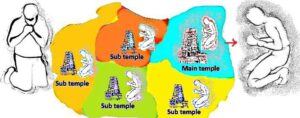
167) Sometimes the manifested divines (tutelary/family deities or other divines) also intruded into rocks or boulders or other lifeless objects (lifeless in outer appearance though each has their own invisible life in them) or remain in anthills for few years before they get traced or dug out. Once they enter into the rocks or boulders, those structures get infused with their divine energies and get reshaped matching with the appearance preferred by them. Centuries later those statues when dug out as commanded by them, they were enshrined in a shrine, and worshiped there. Those temples where the original idols had been thus installed had the powerful divine energies floating in the space which could be felt when one visit there. Such powerful divine energies released direct from the divine will not be available in other temples where the same divine idols were installed.
168) Similarly the anthill, inside which they lived during the period of penance would get filled with their divine energies and sanctified. When temple rose in those places covering the ant hill, the divine energies fill the space inside the temple and throw protective cover to the devotees who visit there. Such forceful divine energies released direct from the divine will not be available in other temples where the same divine idols were installed.
169) Some of the divines never revealed their identity till they completed their penance on earth and after ensuring that the mortal body inside which they stayed during penance get buried below earth or sunk in rivers, the curse reversed divines went back to Deva Loga. Over the years, by acts of nature those bodies became rocks or stones. They were later dug out by the devotees when the same divines revealed to the folks in some manner the spots where their bodies lay buried. Large no of them became Kula Devatha or Tutelary/Family deity centuries later to those who lived in and around there.
170) In the ancient times though many idols of deities were unearthed from several patches of lands in the Villages, only a few of them got enshrined in temples, rest laid in open spaces and placed under the trees in the rural areas. They were worshiped by several families for centuries. Over periods of time many of those villages became cities. Some of those village temples slowly grew into magnificent temples during the reign of great kings who wanted to establish bigger temples when they heard of the powers of those deities. Thus, many of the temples which were initially consecrated with the statues and idols unearthed in many ways (Swayambu or self-manifested idols) either became the Kula Devatha or Tutelary/Family deity to some of descendants of families or remained as temples of commoners. This is also the reason why the temples and Kula Devatha or Tutelary/Family deity as worshiped by most of the family members were still found in remote villages or difficult to reach terrains in forested areas, over the hill, fields, and other remote places.
171) We have to understand the basic fact that the exact period or the place where the temples or some kind of worship shrines were constructed has not been conclusively established. But according to the historians, even during the Vedic period, there were no shrines or temples, but during AD 1500 to AD 1600, few worship places similar to the temples were discovered in Afghanistan and not in India. Similarly though existence of temples were discovered in many parts of Asia such as Cambodia, Thailand, Iran, Pakistan, Malaysia, Singapore, and Africa surprisingly no such shrines or temples were seen in parts of India during that period nor idol worship noticed. However, in the much later part of Vedic period few shrines where some idols have been worshipped in which Sanskrit mantras have been chanted, were seen deep inside the villages. The idols in them were called guardian deities or Village deities. Most of such places of worship were found in make-shift small huts constructed with mud without top roof or were inside small caves as seen here and there.The earliest temple structures were not made of stones or bricks, which came much later. In ancient times, public or community temples were possibly made of clay with thatched roofs made of straw or leaves. Cave-temples were prevalent in remote places and mountainous terrains.
172) The floating divine energies in those places where the idols of Kula Devatha or Tutelary/Family deity were dug out and enshrined embrace the body of the devotees like an invisible cover lasting for some period of time (the extent of period for which the said temporary protection lasts is not known) and block the entry of negative energies intruding into them. Perhaps this is the reason why the ancestors have laid out the principle of visiting the Kula Devatha or Tutelary/Family deity temples everyday if they stayed near the temple vicinity or at least visited once a year to retain the protective cover of divine energies on them.
173) Some may wonder when several hundreds of folks have adapted a deity as their Kula Devatha or Tutelary/Family deity, how is it possible for the deity to personally reach each and individual to guide and guard them? The Kula Devatha or Tutelary/Family deity does not liaise with the individuals or the family directly. Every Kula Devatha or Tutelary/Family deity has fleets of invisible ganas to work on their behalf? Who are those ganas? Several demised forefathers and ancestors of each family members remain as Pithru ganas in Pithru Loga. The moment a family chooses their Kula Devatha or Tutelary/Family deity, immediately the Pithru ganas of those family are called upon from Pithru Loga by the Kula Devatha or Tutelary/Family deity to act as the liasoning ganas between those families and the deity. They in invisible form carry the messages and orders of the Kula Devatha or Tutelary/Family deity to their family lineage. So every family is guided by the Kula Devatha or Tutelary/Family deity through the Pithrus of their families, hence it is always said that the Pithrus are to be kept happy in Pithru Loga by necessary rituals meant to appease them. It is not only the Kula Devatha or Tutelary/Family deity’s command that the family receive thorough Pithrus, but also the commands of other divines prayed by the families are also sent through only through the Pithrus of those family to ensure that they reach the proper person who could be identified only by their Pithrus.
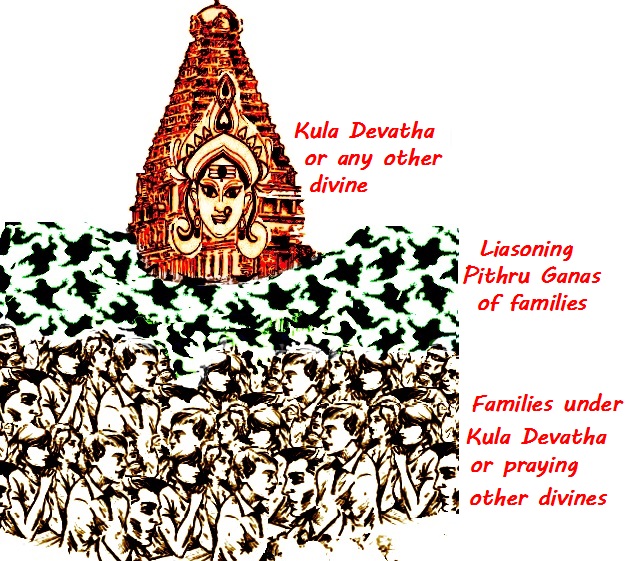
174)The divine principle has been that even if any one of the family members visit the main temple site of their Kula Devatha or Tutelary/Family deity to offer worship at least once in three to five years as a mark of respect to their family deity, that would be sufficient to absorb the invisible divine protective cover which gets automatically transferred to each and every one of their family members even if they remained in faraway places because the divine rays of pleased Kula Devatha or Tutelary/Family deity would travel to any length to protect their members.
175) It does not mean that those devotees who had not adapted the same deity as their Kula Devatha or Tutelary/Family deity but visit the same temple are denied the protective cover. Anyone who visit the temple and offer prayers, too are provided positive energy rays in the form of blessings and protect them for some time, but not to the extent of those under the protective covers of the said Kula Devatha or Tutelary/Family deity
176) Similarly, when a family who held a specific deity as their Kula Devatha or Tutelary/Family deity if chose to ignore the worship of the adapted family deity for any reason, the act would be construed as heinous crime and seven generations of the defaulter’s family would bear the brunt of the of the anger of their Kula Devatha or Tutelary/Family deity thus necessitating the family members of their successive generation to get rid of the sin with several forms of rituals or Vrath or prayers to appease the anger of their family deity.
177) Lastly, it is also surprising to note that over 90 % of the Kula Devatha or Tutelary/Family deities have emerged from rural spaces. As said earlier, their divine powers were also not lesser to the Prime divines and were empowered to directly grant the favours for those who had adapted them as Kula Devatha or Tutelary/Family deity. At the same time, the very same tutelary deities were also empowered to answer the prayers of those who had no Kula Devatha or Tutelary/Family deities but accepted them as Ishta Devatha or general deity in that area. Again, while answering the prayers of general folks, the deities would have to ensure that the groups under their command were not affected in any manner.
178) It is seen that compared to divines manifested in the first three Yugas, more and more manifestations are seen during Kali Yuga. There is manifold increase of divine forces in the present Kali Yuga compared to those mentioned in Vedic scriptures, Ramayana and Mahabharata and many other texts in Hinduism.
179) Before activating and fill up the Universe with souls of several nature, Lord Brahma meticulously worked out various aspects of the creations, the characteristics of each of the Yugas, several divines who would manifest in each of the Yugas including Kula Devatha or Tutelary/Family deity ,the time- frame for each of the manifestations in places assigned to them across the universe etc. How much humans were created and how much divines were needed are explained in later.
180) Is any norm exist as to how many Kula Devatha or Tutelary/Family deities and Village deities can manifest in a space? When Lord Brahma sent divines to spaces, he ensured that, in a space for few hundreds of families, certain no of Kula Devatha or Tutelary/Family deities, Village deities and other guardian deities would be needed and accordingly he sent the ganas there to manifest in those forms. However, the Pundits were unable to explain details on them. It is generally believed that for each space there would be one or two Village deities, a Guardian deity/angel and one or two other divines including Kula Devatha or Tutelary/Family deity.
181) In the history of Kula Devatha or Tutelary/Family deity, a very important and interesting aspect is that the Prime deities like Lord Shiva, Lord Vishnu and Goddess Parvathi have not been adapted as tutelary deities in their original form, but only their subordinate manifestations have been adapted as tutelary deities.
182) However, over period of time here and there they too became Kula Devatha or Tutelary/Family deity in different other forms. Probably because of above reasons we hardly see Prime divines like Lord Shiv, Lord Vishnu, and Lord Brahma, Goddess Parvathi, her manifestations like Goddess Mahalakshmi and Goddess Saraswathi in the category of Kula Devatha or Tutelary/Family deity of any family. The reasons are not clear as to why it is so.
183) How the prayers are answered by the Kula Devatha or Tutelary/Family deities? Let us for example believe that Goddess Kanchi Kamakshi, emanation from Goddess Parvathi has been the Kula Devatha or Tutelary/Family deity of some families and they regularly prayed to her. Whatever prayers they make are answered or blessed by Goddess Kanchi Kamakshi who is their Kula Devatha or Tutelary/Family deity directly because she has been armed with several divine powers to grant the wishes to her devotees who keep worshiping her as their Tutelary/Family deity or Kula Devatha.
184) However, in the case of devotees who had adopted Goddess Kanchi Kamakshi as Ishta Devatha or general deity offer prayers seeking boons, depending upon the nature of boons needed, Goddess Kanchi Kamakshi could act directly, but when the issue involved several folks including those who had their own Kula Devatha or Tutelary/Family deities, Goddess Kanchi Kamakshi may not act without consulting the prime deity Goddess Parvathi from whom she had emanated. Why is it so?
185) One must clearly understand that the title Kula Devatha or Tutelary/Family deities are only extended arms in different forms of the Prime divines as manifested from time to time to enact divine plays. Like in the present management system which function through proper channels in which some fail to get desired effect, some succeed, the divine calls are also set to be routed only through emanations of the Prime deities. The worshipers are put to several tests by way of hurdles and obstacles before getting their boons awarded. The hurdles and obstacles are necessary for two reasons- one to wipe out the past karma (past sins) and the second being to test the true spirits of those who prayed. As said in the initial paras of this article, the Prime divines need assistants to carry out their functions over the vast land of the universe. Hence several divines were/are released from their divine energies over various periods of time to exercise and execute their authority.
186) The lineage of a family is the decedents of the same family members. Century old tradition was that every family owned a Kula Devatha or Tutelary/Family deity and their entire lineage worshiped them. Their main objective was to ensure that the members in their lineages were safeguarded in all aspects in their life as everyone believed that the family deity was more powerful in protecting a family compared to the protection one got from other divines. Beliefs were widespread that only with the grace of the Kula Devatha or Tutelary/Family deities who were worshiped by their ancestors, the souls of demised family members also remain in peace wherever they may be, and similarly the life of the surviving members of the succeeding lineage flourish.
187) It is always said that the Kula Devatha or Tutelary/Family deities safeguard seven of seven generations of a family (which is stated in Tamil as ‘Ezhezhu Jenma vaarisugal’). The true meaning of this is that a Kula Devatha or Tutelary/Family deity of a family safeguard the interest of 49 lineages of the same families and the 50th generation would be free to choose another deity as their Kula Devatha or Tutelary/Family deity or continue to worship the same deity. A catch here again. If the 50th generation opts the same deity as Kula Devatha or Tutelary/Family deity then the next 49 generations in their lineage would also have to continue the worship of the same deity. But it never happens so say the pundits.
188) No Kula Devatha or Tutelary/Family deity is worshiped beyond thirteen generations (13) on an average as the link gets broken somewhere mid-way because the lineage of a family is kept continued only through the direct male members of the family. Rarely the calculation changes say the Pundits because many families do not have children at all, many have only female, some have only one or two children etc. The female members in the families after their marriage are obliged to adapt Kula Devatha or Tutelary/Family deity of their husband’s side.
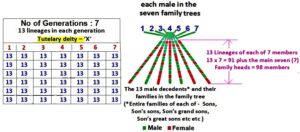
Let us understand the above by the following example.
One group/Kula
No of Generations : 7
Males in each generation:7
Lineages in the family of each male : 13
Total lineages : 13 x 7 = 91
189)Thus total no of families under Kula Devatha or Tutelary/Family deity works out to 91(7×13)+7=98 lineages. Since on an average of not more than 50% of the children are born as male in each generation of families, it is said that maximum 49 (98÷2=49) generations of a family tree (Kula) get protected by Kula Devatha or Tutelary/Family deity because the family tree or Kula of specific generation expands only through the male members of the family. Once the female members get married automatically they belongs to the other family group. Hence the generation continues through only the male members of the families.
190) Generally, the Brahman rule was that a family do not survive beyond 49 generations because in the lineage chain some member may not have male issues, and some may not have children too. Therefore, if one practically see, at some point of time in 13th generation the continuation of worship of Kula Devatha or Tutelary/Family deity gets disconnected so say the pundits.
Part- 10 Continued…….
—————————————————-
References:- Some of the information found in the following sites, folk lores, discussions with temple Pundits and elders of yester year generations helped me in compiling the above article.
(1) https://www.tirumala.org/MoreTemples.aspx
(2) https://www.thehindu.com/society/work-in-progress-to-restore-ancient-village-temples
(3) https://timesofindia.indiatimes.com/city/hubballi/temple-village-cries-for-attention
(4) https://timesofindia.indiatimes.com/city/mangaluru/villagers-unite-to-bring-800-year-
(5) https://www.newindianexpress.com/states/andhra-pradesh/2022/jan/10/only-men-
(6) https://unesdoc.unesco.org/in/documentViewer.xhtml?v=2.1.196&
(7) https://www.ndtv.com/world-news/lord-vishnus-1-300-year-old-temple-discovered-in-
(8) https://en.wikipedia.org/wiki/Hinduism_in_Afghanistan
(9) https://www.learnreligions.com/history-of-hindu-temples-1770625
(10) https://en.wikipedia.org/wiki/Historical_Vedic_religion
(11) https://karaikudiexpress.wordpress.com/2020/08/02/kula-deivam
(12) https://kaulapedia.com/en/kula-devta/
(13) https://sites.google.com/site/wwwkalibaburbarijanaicom/home/kuladevata-family-deity-of-the-family
——————————
Acknowledgement: I acknowledge with grateful thanks, Dr. V. Sankarkumar, consultant medical officer in USA, who edited my article with valuable inputs before publishing it. He has been writing articles of spiritual nature in both Tamil and in English and has contributed much in one of the Shirdi Saibaba blogger (https://shirdisaibabatamilstories.blogspot.com/-in which I was one of the two coordinators) by translating the English articles into Tamil. …..N.R. Jayaraman (nrj1945@gmail.com).


